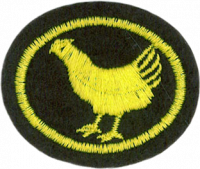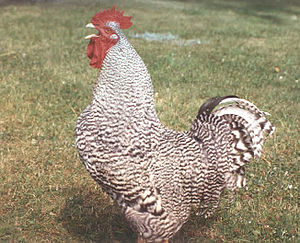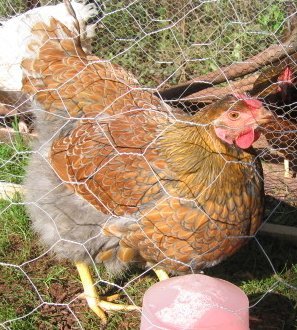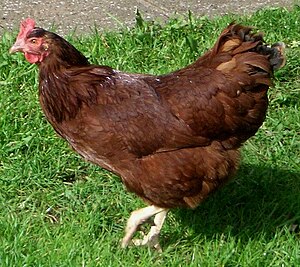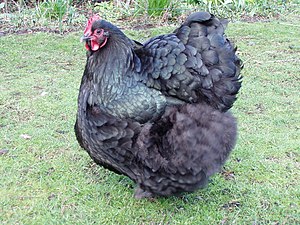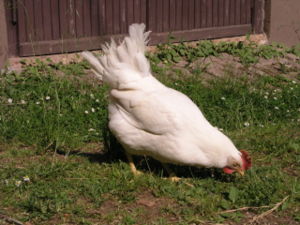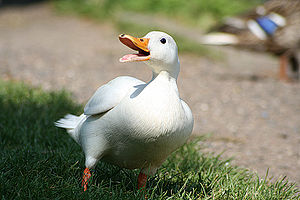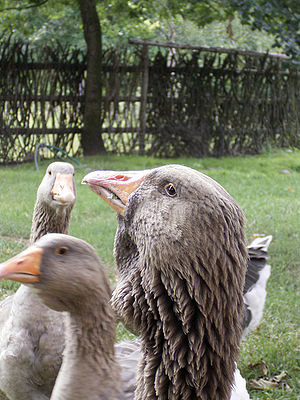Difference between revisions of "AY Honors/Poultry Raising/Answer Key"
(+ problematic template) |
|||
| (9 intermediate revisions by 3 users not shown) | |||
| Line 1: | Line 1: | ||
| − | < | + | {{HonorSubpage}} |
| − | <noinclude><translate><!--T: | + | <section begin="Body" /> |
| + | {{ansreq|page={{#titleparts:{{PAGENAME}}|2|1}}|num=1}} | ||
| + | <noinclude><translate><!--T:42--> | ||
</noinclude> | </noinclude> | ||
| − | + | <!-- 1. Have the Poultry Honor. --> | |
| − | |||
| − | |||
| − | |||
| − | |||
| − | |||
| − | |||
| − | |||
| − | |||
| − | |||
| − | |||
{{honor_prerequisite|category=Nature|honor=Poultry}} | {{honor_prerequisite|category=Nature|honor=Poultry}} | ||
| − | ==2. Tell briefly the egg-laying or meat-producing qualities of the following:== <!--T: | + | <!--T:43--> |
| − | + | <noinclude></translate></noinclude> | |
| − | {{: | + | {{CloseReq}} <!-- 1 --> |
| + | {{ansreq|page={{#titleparts:{{PAGENAME}}|2|1}}|num=2}} | ||
| + | <noinclude><translate><!--T:44--> | ||
| + | </noinclude> | ||
| + | <!-- 2. Tell briefly the egg-laying or meat-producing qualities of the following: --> | ||
| + | <noinclude></translate></noinclude> | ||
| + | {{ansreq|page={{#titleparts:{{PAGENAME}}|2|1}}|num=2a}} | ||
| + | <noinclude><translate><!--T:45--> | ||
| + | </noinclude> | ||
| + | {{:AY Honors/Poultry/Plymouth Rock}} | ||
| − | == | + | <!--T:46--> |
| − | {{: | + | <noinclude></translate></noinclude> |
| + | {{CloseReq}} <!-- 2a --> | ||
| + | {{ansreq|page={{#titleparts:{{PAGENAME}}|2|1}}|num=2b}} <!--T:4--> | ||
| + | <noinclude><translate><!--T:47--> | ||
| + | </noinclude> | ||
| + | {{:AY Honors/Poultry/Wyandotte}} | ||
| − | == | + | <!--T:48--> |
| − | {{: | + | <noinclude></translate></noinclude> |
| + | {{CloseReq}} <!-- 2b --> | ||
| + | {{ansreq|page={{#titleparts:{{PAGENAME}}|2|1}}|num=2c}} <!--T:5--> | ||
| + | <noinclude><translate><!--T:49--> | ||
| + | </noinclude> | ||
| + | {{:AY Honors/Poultry/Rhode Island Red}} | ||
| − | == | + | <!--T:50--> |
| − | {{: | + | <noinclude></translate></noinclude> |
| + | {{CloseReq}} <!-- 2c --> | ||
| + | {{ansreq|page={{#titleparts:{{PAGENAME}}|2|1}}|num=2d}} <!--T:6--> | ||
| + | <noinclude><translate><!--T:51--> | ||
| + | </noinclude> | ||
| + | {{:AY Honors/Poultry/Orpington}} | ||
| − | == | + | <!--T:52--> |
| − | {{: | + | <noinclude></translate></noinclude> |
| + | {{CloseReq}} <!-- 2d --> | ||
| + | {{ansreq|page={{#titleparts:{{PAGENAME}}|2|1}}|num=2e}} <!--T:7--> | ||
| + | <noinclude><translate><!--T:53--> | ||
| + | </noinclude> | ||
| + | {{:AY Honors/Poultry/Leghorn}} | ||
| − | == | + | <!--T:54--> |
| − | {{ | + | <noinclude></translate></noinclude> |
| − | |Peking duck is a mean in Beijing (Peking) while the Pekin Duck is a breed of poultry. | + | {{CloseReq}} <!-- 2e --> |
| + | {{ansreq|page={{#titleparts:{{PAGENAME}}|2|1}}|num=2f}} <!--T:8--> | ||
| + | <noinclude><translate><!--T:55--> | ||
| + | </noinclude> | ||
| + | {{AY Honors/Problematic requirement | ||
| + | |Peking duck is a mean in Beijing (Peking) while the Pekin Duck is a breed of poultry. | ||
|Pekin Duck | |Pekin Duck | ||
}} | }} | ||
| − | {{: | + | <!--T:40--> |
| + | {{:AY Honors/Poultry/Pekin Duck}} | ||
| − | == | + | <!--T:56--> |
| − | {{: | + | <noinclude></translate></noinclude> |
| + | {{CloseReq}} <!-- 2f --> | ||
| + | {{ansreq|page={{#titleparts:{{PAGENAME}}|2|1}}|num=2g}} <!--T:9--> | ||
| + | <noinclude><translate><!--T:57--> | ||
| + | </noinclude> | ||
| + | {{:AY Honors/Poultry/Mammoth Bronze Turkey}} | ||
| − | == | + | <!--T:58--> |
| − | {{: | + | <noinclude></translate></noinclude> |
| + | {{CloseReq}} <!-- 2g --> | ||
| + | {{ansreq|page={{#titleparts:{{PAGENAME}}|2|1}}|num=2h}} <!--T:10--> | ||
| + | <noinclude><translate><!--T:59--> | ||
| + | </noinclude> | ||
| + | {{:AY Honors/Poultry/White Holland Turkey}} | ||
| − | == | + | <!--T:60--> |
| − | {{: | + | <noinclude></translate></noinclude> |
| + | {{CloseReq}} <!-- 2h --> | ||
| + | {{ansreq|page={{#titleparts:{{PAGENAME}}|2|1}}|num=2i}} <!--T:11--> | ||
| + | <noinclude><translate><!--T:61--> | ||
| + | </noinclude> | ||
| + | {{:AY Honors/Poultry/Toulouse Goose}} | ||
| − | ==3. What is the purpose of the following: == <!--T: | + | <!--T:62--> |
| − | + | <noinclude></translate></noinclude> | |
| − | An Incubator is a chamber designed to hold fertile eggs at a controlled temperature and humidity. | + | {{CloseReq}} <!-- 2i --> |
| + | {{CloseReq}} <!-- 2 --> | ||
| + | {{ansreq|page={{#titleparts:{{PAGENAME}}|2|1}}|num=3}} | ||
| + | <noinclude><translate><!--T:63--> | ||
| + | </noinclude> | ||
| + | <!-- 3. What is the purpose of the following: --> | ||
| + | <noinclude></translate></noinclude> | ||
| + | {{ansreq|page={{#titleparts:{{PAGENAME}}|2|1}}|num=3a}} | ||
| + | <noinclude><translate><!--T:64--> | ||
| + | </noinclude> | ||
| + | An Incubator is a chamber designed to hold fertile eggs at a controlled temperature and humidity. If temperature is held to 101.5°F, the eggs will hatch after 21 days. An incubator is needed for hatching eggs if the hen is unavailable (such is the case if the fertile eggs are bought from a supplier). | ||
| − | == | + | <!--T:65--> |
| − | A hover, also called a ''brooder'', is similar to a large, shallow upturned box with legs to raise it off the floor. | + | <noinclude></translate></noinclude> |
| + | {{CloseReq}} <!-- 3a --> | ||
| + | {{ansreq|page={{#titleparts:{{PAGENAME}}|2|1}}|num=3b}} <!--T:13--> | ||
| + | <noinclude><translate><!--T:66--> | ||
| + | </noinclude> | ||
| + | A hover, also called a ''brooder'', is similar to a large, shallow upturned box with legs to raise it off the floor. Heat lamps are mounted on the inside of the box. Chicks gather under the hover for warmth. | ||
| − | == | + | <!--T:67--> |
| − | A sanitary fowl house is a small structure (typically 6'x4'x6' tall) designed to securely house poultry. | + | <noinclude></translate></noinclude> |
| + | {{CloseReq}} <!-- 3b --> | ||
| + | {{ansreq|page={{#titleparts:{{PAGENAME}}|2|1}}|num=3c}} <!--T:14--> | ||
| + | <noinclude><translate><!--T:68--> | ||
| + | </noinclude> | ||
| + | A sanitary fowl house is a small structure (typically 6'x4'x6' tall) designed to securely house poultry. The house is partitioned into several small rooms suitable for housing a few birds each. The bottom of each room is screened so that waste falls away from the fowl. | ||
| − | == | + | <!--T:69--> |
| − | A coop is a building where poultry are kept. | + | <noinclude></translate></noinclude> |
| + | {{CloseReq}} <!-- 3c --> | ||
| + | {{ansreq|page={{#titleparts:{{PAGENAME}}|2|1}}|num=3d}} <!--T:15--> | ||
| + | <noinclude><translate><!--T:70--> | ||
| + | </noinclude> | ||
| + | A coop is a building where poultry are kept. The inside of the coop normally consists of several nesting boxes just large enough for the birds to sit in while laying their eggs, as well as perches for the them to use while sleeping. Often the floor of the coop is covered with a material, such as straw or wood chips, to contain the bird waste, and to allow easier cleanup of the coop. Sometimes the coop contains feeding and watering devices for the birds, but these may also be kept outside of the coop, in the run. Most have some kind of ventilation to help air out any odors that may occur. | ||
<!--T:16--> | <!--T:16--> | ||
Since poultry are often prone to illness from drafts and poor weather, coops are best designed to be warm at cold times, cool at hot times, and as draft free as possible. | Since poultry are often prone to illness from drafts and poor weather, coops are best designed to be warm at cold times, cool at hot times, and as draft free as possible. | ||
| − | == | + | <!--T:71--> |
| − | Runs are fenced in areas for poultry to get fresh air and exercise. | + | <noinclude></translate></noinclude> |
| + | {{CloseReq}} <!-- 3d --> | ||
| + | {{ansreq|page={{#titleparts:{{PAGENAME}}|2|1}}|num=3e}} <!--T:17--> | ||
| + | <noinclude><translate><!--T:72--> | ||
| + | </noinclude> | ||
| + | Runs are fenced in areas for poultry to get fresh air and exercise. If runs are not used most people let their birds roam free during the day. | ||
| − | ==4. Candle a number of eggs, finding at least one bad egg. What is the purpose of candling eggs? | + | <!--T:73--> |
| − | You will need to build a simple apparatus to candle your eggs. | + | <noinclude></translate></noinclude> |
| + | {{CloseReq}} <!-- 3e --> | ||
| + | {{CloseReq}} <!-- 3 --> | ||
| + | {{ansreq|page={{#titleparts:{{PAGENAME}}|2|1}}|num=4}} | ||
| + | <noinclude><translate><!--T:74--> | ||
| + | </noinclude> | ||
| + | <!-- 4. Candle a number of eggs, finding at least one bad egg. What is the purpose of candling eggs? --> | ||
| + | You will need to build a simple apparatus to candle your eggs. It is simply an opaque box with a lightbulb inside, and a hole slightly smaller than the diameter of an egg cut into the top. | ||
<!--T:19--> | <!--T:19--> | ||
| − | Place an egg on the hole and turn on the light. | + | Place an egg on the hole and turn on the light. If you see a cloudy formation inside the egg, you can assume that it has been fertilized (the cloud is a developing embryo). This should be done after 2 or 3 days of incubation. Candling will also reveal cracks in the shell, and a cracked egg is unlikely to develop into a bird. |
<!--T:20--> | <!--T:20--> | ||
| − | The purpose of candling is to determine which eggs have been fertilized and to detect bad eggs. | + | The purpose of candling is to determine which eggs have been fertilized and to detect bad eggs. Not all of the eggs are likely to be fertile. Fertility rates range from 50% to 95% in a healthy flock, with a 75% hatch rate being very good. |
<!--T:21--> | <!--T:21--> | ||
| − | Always remove unfertilized eggs from the incubator. | + | Always remove unfertilized eggs from the incubator. If you let them go, they will rot. |
| − | ==5. Outline the feeding program for domestic fowl, from hatching to maturity. == <!--T: | + | <!--T:75--> |
| − | + | <noinclude></translate></noinclude> | |
| + | {{CloseReq}} <!-- 4 --> | ||
| + | {{ansreq|page={{#titleparts:{{PAGENAME}}|2|1}}|num=5}} | ||
| + | <noinclude><translate></noinclude> | ||
| + | <!-- 5. Outline the feeding program for domestic fowl, from hatching to maturity. --> | ||
| + | ===Hatchlings=== <!--T:76--> | ||
It's pretty much obvious, but baby chickens need to drink. Under | It's pretty much obvious, but baby chickens need to drink. Under | ||
no circumstances give them un-boiled water. Their immune systems might | no circumstances give them un-boiled water. Their immune systems might | ||
| Line 98: | Line 182: | ||
===Adults=== <!--T:25--> | ===Adults=== <!--T:25--> | ||
| − | Feeding chickens is almost as easy as watering them. | + | Feeding chickens is almost as easy as watering them. In nature chickens are the garbage cleaners of the Southeast Asian Jungle. For everyday food you can feed your chickens either chicken food (found at feed stores) or pig food. In Alberta the UFA Hog Grower is the same as the chick starter except the pellets are bigger, and the hog grower contains less antibiotics. If you have access to grain then you can feed that to them. Whenever you make food with lots of scraps (peelings and bits of vegetables that humans shouldn't eat) then feed those to them. Chickens can be trained so well if they see a small bucket (for carrying chicken scraps) they get excited because a treat is coming. You can feed your chickens in a trough, appropriate sized container, or by scattering the food on the ground. You can even give your chickens bones with scraps of meat on them. There is very little that they won't eat. |
=== Information Specific to Laying Hens === <!--T:26--> | === Information Specific to Laying Hens === <!--T:26--> | ||
| − | Laying hens require calcium for egg shells. During the laying season, put a pile or box of crushed clam shells in their pen. Crushed clam shells are available at most local feed/farm stores. If you scatter the clam shells too much, you won't know when the hens need more until you see paper-thin shells. Egg shells also work for the calcium, but you run the risk of the birds learning to eat their own eggs. | + | Laying hens require calcium for egg shells. During the laying season, put a pile or box of crushed clam shells in their pen. Crushed clam shells are available at most local feed/farm stores. If you scatter the clam shells too much, you won't know when the hens need more until you see paper-thin shells. Egg shells also work for the calcium, but you run the risk of the birds learning to eat their own eggs. To avoid this you should crush the shells so that they don't look like eggs. |
| Line 113: | Line 197: | ||
|- | |- | ||
|Orange peels | |Orange peels | ||
| − | |Too tough for chickens to chew on. | + | |Too tough for chickens to chew on. Chickens will play with them if they are bored though. |
|- | |- | ||
|Watermellon rinds | |Watermellon rinds | ||
| Line 123: | Line 207: | ||
|- | |- | ||
|Chicken | |Chicken | ||
| − | |Because they ''are'' chickens. | + | |Because they ''are'' chickens. Although chickens will happily eat chicken and other meat products. After [[Raising_Chickens/Death/Butchering|butchering]] a chicken you can leave the skeleton in the pen and they will pick the bones clean. If done on a large scale, making chicken feed from chickens (especially the brain and spinal cord) can lead to an outbreak of [[w:Transmissible spongiform encephalopathy|encephalopathy]], similar to mad cow disease. |
|- | |- | ||
|Carrots | |Carrots | ||
| Line 140: | Line 224: | ||
|Not a problem in small quantities. In excess reduces the droppings. | |Not a problem in small quantities. In excess reduces the droppings. | ||
|- | |- | ||
| − | |Apple | + | |Apple |
|It is fine to give one apple to four birds once every two weeks if given too regular it may give them a stomach upset | |It is fine to give one apple to four birds once every two weeks if given too regular it may give them a stomach upset | ||
|- | |- | ||
| Line 146: | Line 230: | ||
|} | |} | ||
| − | ==6. What is the temperature, humidity, and number of days needed to hatch the following eggs: a. Duck; b. Chicken; c. Goose; d. Quail; e. Turkey | + | <!--T:77--> |
| + | <noinclude></translate></noinclude> | ||
| + | {{CloseReq}} <!-- 5 --> | ||
| + | {{ansreq|page={{#titleparts:{{PAGENAME}}|2|1}}|num=6}} | ||
| + | <noinclude><translate><!--T:78--> | ||
| + | </noinclude> | ||
| + | <!-- 6. What is the temperature, humidity, and number of days needed to hatch the following eggs: a. Duck; b. Chicken; c. Goose; d. Quail; e. Turkey --> | ||
<!--T:29--> | <!--T:29--> | ||
| Line 153: | Line 243: | ||
!align="center"|Fowl ||Duck ||Chicken ||Goose || Quail || Turkey | !align="center"|Fowl ||Duck ||Chicken ||Goose || Quail || Turkey | ||
|- | |- | ||
| − | |align="center"|'''Temperature''' ||99.5°F ||99.5°F ||99.5°F||99.5°F ||99.5°F | + | |align="center"|'''Temperature''' ||99.5°F ||99.5°F ||99.5°F||99.5°F ||99.5°F |
|- | |- | ||
| − | |align="center"|'''Humidity''' ||60% ||60-65% ||65% ||55% ||55% | + | |align="center"|'''Humidity''' ||60% ||60-65% ||65% ||55% ||55% |
|- | |- | ||
|align="center"|'''Number of Days'''||28 ||21 ||28-34 ||23 ||28 | |align="center"|'''Number of Days'''||28 ||21 ||28-34 ||23 ||28 | ||
|} | |} | ||
| − | ==7. Make, buy, or rent an incubator and hatch six poultry eggs of your choice, with a 50% hatch. | + | <!--T:79--> |
| − | Buying a new incubator is certainly the most convenient of these options, though you will pay a handsome price for the convenience. | + | <noinclude></translate></noinclude> |
| + | {{CloseReq}} <!-- 6 --> | ||
| + | {{ansreq|page={{#titleparts:{{PAGENAME}}|2|1}}|num=7}} | ||
| + | <noinclude><translate><!--T:80--> | ||
| + | </noinclude> | ||
| + | <!-- 7. Make, buy, or rent an incubator and hatch six poultry eggs of your choice, with a 50% hatch. --> | ||
| + | Buying a new incubator is certainly the most convenient of these options, though you will pay a handsome price for the convenience. If you are planning to enter the poultry trade for the long term, it would probably be worth it. Otherwise, you should look into renting, buying used, or (if you possess the skills) building one yourself. | ||
<!--T:31--> | <!--T:31--> | ||
| − | http://msucares.com/poultry/reproductions/poultry_make_incubator.html has plans for building two incubators; one from a polystyrene ice chest, and a more permanent model from plywood. | + | http://msucares.com/poultry/reproductions/poultry_make_incubator.html has plans for building two incubators; one from a polystyrene ice chest, and a more permanent model from plywood. A quick Internet search will turn up even more plans for you to choose from. |
<!--T:32--> | <!--T:32--> | ||
| − | Once you have an incubator, it is very important to operate it for several hours ''before you add any eggs to it''. | + | Once you have an incubator, it is very important to operate it for several hours ''before you add any eggs to it''. These "practice" runs will help you learn to operate it at the proper and constant temperature. Do not add eggs until you have achieved stable operation at the required temperature. If you overheat the eggs, they will not hatch. |
<!--T:33--> | <!--T:33--> | ||
| − | Once the incubator is on operation, you will be required to turn the eggs three times per day. | + | Once the incubator is on operation, you will be required to turn the eggs three times per day. If your incubator has an automatic turner built-in, this will obviously be a lot easier. Otherwise, mark one side of each egg with an '''''X''''', and the other side with an '''''O''''', and place all the eggs in the incubator with either the '''''X''''' or the '''''O''''' side up. This will help you keep track of which eggs you have already turned. |
<!--T:34--> | <!--T:34--> | ||
| − | A few days before hatching (exactly how many days depends on the species) you should quit turning the eggs and boost the humidity. | + | A few days before hatching (exactly how many days depends on the species) you should quit turning the eggs and boost the humidity. Once the eggs hatch, you can leave the hatchlings in the incubator for several days until they are large enough to use the hover. |
<!--T:35--> | <!--T:35--> | ||
Incubators generally have a wire mesh floor that can be easily lifted out for cleaning. | Incubators generally have a wire mesh floor that can be easily lifted out for cleaning. | ||
| − | ==8. Raise these fowl for at least three months. | + | <!--T:81--> |
| + | <noinclude></translate></noinclude> | ||
| + | {{CloseReq}} <!-- 7 --> | ||
| + | {{ansreq|page={{#titleparts:{{PAGENAME}}|2|1}}|num=8}} | ||
| + | <noinclude><translate><!--T:82--> | ||
| + | </noinclude> | ||
| + | <!-- 8. Raise these fowl for at least three months. --> | ||
Have fun! | Have fun! | ||
| Line 184: | Line 286: | ||
You can usually find information on poultry care for your specific breed on the internet or at your library. | You can usually find information on poultry care for your specific breed on the internet or at your library. | ||
| + | <!--T:83--> | ||
| + | <noinclude></translate></noinclude> | ||
| + | {{CloseReq}} <!-- 8 --> | ||
| + | <noinclude><translate></noinclude> | ||
==References== <!--T:38--> | ==References== <!--T:38--> | ||
<!--T:39--> | <!--T:39--> | ||
* http://www.canteach.ca/elementary/life20.html | * http://www.canteach.ca/elementary/life20.html | ||
| − | |||
[[Category:Adventist Youth Honors Answer Book|{{SUBPAGENAME}}]] | [[Category:Adventist Youth Honors Answer Book|{{SUBPAGENAME}}]] | ||
<noinclude></translate></noinclude> | <noinclude></translate></noinclude> | ||
| + | {{CloseHonorPage}} | ||
Latest revision as of 00:41, 21 September 2021
1
For tips and instruction see Poultry.
2
2a
Plymouth Rock
The Plymouth Rock is a chicken breed that originated in the United States in the 19th century and is still popular to this day. John C. Bennett (1804-1867) has been credited with either creating or popularizing the breed. They were developed in New England in the early 1800's by crossing Dominiques and Black Javas. It was bred as a dual-purpose fowl, meaning that it was valued both for its meat and the hens' egg-laying ability. A hen will lay between 50 and 100 eggs per year. It is a cold-hardy bird and therefore makes a great breed for the small farm or backyard flock owner. There are seven varieties of Plymouth Rock chickens: barred, blue, buff, Columbian, partridge, silver-penciled and white.
2b
Wyandotte
The Wyandotte is a medium sized breast with a rose comb and clean legs. The chicken feathers are broad and close fitting. The area around the vent is very fluffy. The legs are yellow. The Wyandotte is a breed that suits both free range and confinement in a run. The hens will lay around 200 eggs a year with an exceptional hen laying around 240 eggs a year. The eggs are tinted.
2c
Rhode Island Red
Its feathers are a Mahogany dark red/brown lustre, bordering on black. Some have purple spots or green stripes. They have red/orange eyes and yellow feet. Chicks are a light red to tan color with two dark brown bars running down their backs. Rhode Island Reds are tough birds, resistant to illness, good at foraging and free ranging, and are typically docile, quiet and friendly. Though males can be considerably aggressive. Rhode Island Reds are excellent egg layers, producing up to 250 to 300 large, light brown eggs per year. Rhode Island Reds are also bred for meat, with Cockerels weighing in at around four kilograms, and Hens slightly less.
2d
Orpington
The Orpington is a large bird from the English class of chickens. It is a bold, upright breed with a wide chest, broad back, and smallish head and tail. The Orpington was bred as a dual-purpose breed (meat production and eggs), but its popularity grew as a show bird rather than a utility breed. Their large size and soft appearance together with their rich color and gentle contours make them very attractive. Orpingtons lay between 110 and 160 eggs a year. They do not stop laying in the winter. The eggs are tinted and range from small to large depending on the heredity of the breed.
2e
Leghorn
Leghorns, and leghorn crossbreeds, are one of the most popular commercial breeds of chicken worldwide, and while the majority are white, a number of colored breeds also exist. Leghorns are excellent layers of white eggs (around 300 per year), but they can be noisy, flighty, easily excited, and aggressive. Because of their aggression, they are not recommended for backyard-operations. Leghorns mature quickly, but are generally neither considered to be large birds nor suitable for meat.
2f
| Note: The editors of this answer book feel that there is an error in the official version of this requirement. More Information Peking duck is a mean in Beijing (Peking) while the Pekin Duck is a breed of poultry.
|
Pekin duck
A Pekin duck is a breed of domesticated duck used primarily for egg and meat production. Bred from the Mallard in China, nine ducks were imported to the United States in 1873. It is the most popular commercial duck breed in the United States. These ducks are ready for butchering at 6 to 8 weeks of age and produce more meat that is desirable for eating than other breeds of duck. Its meat is very tender and mild and well-suited for many menu options. The eggs are slightly larger than a large chicken egg, and tend to have a more durable shell and stronger membrane which makes them harder to crack open than a chicken egg. Duck eggs have more protein, calcium and many vitamins, as well as more fat and cholesterol, per gram than a chicken egg. Duck eggs are very similar in flavor and texture to a chicken egg. They can usually be substituted for large or jumbo eggs in recipes. The mascot of the insurance company Aflac is a Pekin duck.
2g
Mammoth Bronze turkey
The Mammoth Bronze is similar to the wild turkey, but it is quite a bit larger. Its feathers are an iridescent black with hints of green. The feathers of the rump have bronze coloring (thus the name), while the feathers in the front have hints of red and green.
It is calmer than most other breeds which makes them quite a bit easier to handle. Some people even use them as pets, though it is more common for them to be used for meat production. Toms weigh between 25 and 40 pounds, while hens weigh between 14 and 26 pounds.
The broad-breasted is more common than the "unimproved" variety. The large breast interferes with natural mating, so they must be artificially inseminated.
For images of the Mammoth Bronze, search online.
2h
White Holland turkey
The White Holland is the ancestor of the Broad-Breasted White, the most commonly produced breed of domestic turkey. True White Hollands are extremely rare these days and are bred primarily by enthusiasts. It has white feathers, pink feet, shanks, throat and wattle.
For images, see
2i
Toulouse goose
The Toulouse goose has greyish-brown feathers on top, with white feathers underneath. The most distinguishing characteristic is a pronounced dewlap, which is a flap of loose skin beneath the chin. The bird is of a very trusting nature and has a very placid disposition, with the consequence that these birds do not thrive in flocks of mixed breeds. The more active and aggressive breeds will greatly distress the bird, putting them of mating and sometimes resulting in them losing out at the feeding trough. They are very domestic birds and will easily be bewildered by more active breeds if mixed. They do not need water or a pond and the geese never mate in water. They rarely have problems producing fertile eggs, although problems can occur during severe weather in the winter and spring, which is the case with most breeds of geese. The breed is a good layer of eggs and will equal the best of any goose breed. A good goose will lay up to 100 eggs a year. However the birds are not good sitters, the sitting habit having been bred out of some birds. The breed makes an excellent table bird. The geese are not great wanderers and preferring to stay close to home making them ideal for a large garden or an orchard where the birds will thrive.
3
3a
An Incubator is a chamber designed to hold fertile eggs at a controlled temperature and humidity. If temperature is held to 101.5°F, the eggs will hatch after 21 days. An incubator is needed for hatching eggs if the hen is unavailable (such is the case if the fertile eggs are bought from a supplier).
3b
A hover, also called a brooder, is similar to a large, shallow upturned box with legs to raise it off the floor. Heat lamps are mounted on the inside of the box. Chicks gather under the hover for warmth.
3c
A sanitary fowl house is a small structure (typically 6'x4'x6' tall) designed to securely house poultry. The house is partitioned into several small rooms suitable for housing a few birds each. The bottom of each room is screened so that waste falls away from the fowl.
3d
A coop is a building where poultry are kept. The inside of the coop normally consists of several nesting boxes just large enough for the birds to sit in while laying their eggs, as well as perches for the them to use while sleeping. Often the floor of the coop is covered with a material, such as straw or wood chips, to contain the bird waste, and to allow easier cleanup of the coop. Sometimes the coop contains feeding and watering devices for the birds, but these may also be kept outside of the coop, in the run. Most have some kind of ventilation to help air out any odors that may occur.
Since poultry are often prone to illness from drafts and poor weather, coops are best designed to be warm at cold times, cool at hot times, and as draft free as possible.
3e
Runs are fenced in areas for poultry to get fresh air and exercise. If runs are not used most people let their birds roam free during the day.
4
You will need to build a simple apparatus to candle your eggs. It is simply an opaque box with a lightbulb inside, and a hole slightly smaller than the diameter of an egg cut into the top.
Place an egg on the hole and turn on the light. If you see a cloudy formation inside the egg, you can assume that it has been fertilized (the cloud is a developing embryo). This should be done after 2 or 3 days of incubation. Candling will also reveal cracks in the shell, and a cracked egg is unlikely to develop into a bird.
The purpose of candling is to determine which eggs have been fertilized and to detect bad eggs. Not all of the eggs are likely to be fertile. Fertility rates range from 50% to 95% in a healthy flock, with a 75% hatch rate being very good.
Always remove unfertilized eggs from the incubator. If you let them go, they will rot.
5
Hatchlings
It's pretty much obvious, but baby chickens need to drink. Under no circumstances give them un-boiled water. Their immune systems might not handle the germs just yet. Grain coffee (coffee made from oats or summat, as opposed to coffee made from coffee beans) is quite suitable for them. Make sure it's not hot. A good way to serve drink is to pour it into a large wide-mouthed jar, put a dish on top of the jar upside down, then flip the whole thing, so that the jar is upside down, standing on the dish. It should leak just enough coffee onto the dish so that the baby chickens can have a drink, and leak more when they have drunk some.
Baby chickens won't eat just any old thing. Milled oats are a good thing to feed them, at least initially. Hard boiled eggs (cut up into appropriate bite sized pieces, of course) go with the milled oats quite well. You may want to ask around in agriculture stores about special feed for baby chickens. DON'T FEED THEM BREAD! It will kill them. It's good to add cut-up lettuce to the baby chickens' diet. If you're not squeamish, small, flightless bugs, like centipedes can be entertaining, as well as nutritional to the chickens, just don't give those straight off to new-hatches, okay?
Grown Up (But Still Baby) Chicks
Remember those special foods for baby chickens? It's a kind of meal, only with vitamins, minerals and what not. It's good for them. Mashed potatoes mixed with that meal, are better. And the chickens like it VERY much. Cut-up lettuce, cabbage, grass is fine at this point. Insects are always welcome.
Adults
Feeding chickens is almost as easy as watering them. In nature chickens are the garbage cleaners of the Southeast Asian Jungle. For everyday food you can feed your chickens either chicken food (found at feed stores) or pig food. In Alberta the UFA Hog Grower is the same as the chick starter except the pellets are bigger, and the hog grower contains less antibiotics. If you have access to grain then you can feed that to them. Whenever you make food with lots of scraps (peelings and bits of vegetables that humans shouldn't eat) then feed those to them. Chickens can be trained so well if they see a small bucket (for carrying chicken scraps) they get excited because a treat is coming. You can feed your chickens in a trough, appropriate sized container, or by scattering the food on the ground. You can even give your chickens bones with scraps of meat on them. There is very little that they won't eat.
Information Specific to Laying Hens
Laying hens require calcium for egg shells. During the laying season, put a pile or box of crushed clam shells in their pen. Crushed clam shells are available at most local feed/farm stores. If you scatter the clam shells too much, you won't know when the hens need more until you see paper-thin shells. Egg shells also work for the calcium, but you run the risk of the birds learning to eat their own eggs. To avoid this you should crush the shells so that they don't look like eggs.
| Common food that chickens shouldn't/won't eat | |
|---|---|
| Food | Reason |
| Orange peels | Too tough for chickens to chew on. Chickens will play with them if they are bored though. |
| Watermellon rinds | Too thick/tough for chickens to chew on |
| Rye kernels | Chickens don't like them |
| Chicken | Because they are chickens. Although chickens will happily eat chicken and other meat products. After butchering a chicken you can leave the skeleton in the pen and they will pick the bones clean. If done on a large scale, making chicken feed from chickens (especially the brain and spinal cord) can lead to an outbreak of encephalopathy, similar to mad cow disease. |
| Carrots | Chickens can't eat large hard chunks but they will eat carrot peels. |
| Curry | They like it, but it has bad effects on their droppings. |
| Banana | They just don't like them eitherDisputed |
| Potato Peel | Chickens normally don't like very many root plants, so they will not usually eat potato peels. |
| Tomato | Not a problem in small quantities. In excess reduces the droppings. |
| Apple | It is fine to give one apple to four birds once every two weeks if given too regular it may give them a stomach upset |
| Feel free to add items that you have found chickens shouldn't or won't eat | |
6
| Fowl | Duck | Chicken | Goose | Quail | Turkey |
|---|---|---|---|---|---|
| Temperature | 99.5°F | 99.5°F | 99.5°F | 99.5°F | 99.5°F |
| Humidity | 60% | 60-65% | 65% | 55% | 55% |
| Number of Days | 28 | 21 | 28-34 | 23 | 28 |
7
Buying a new incubator is certainly the most convenient of these options, though you will pay a handsome price for the convenience. If you are planning to enter the poultry trade for the long term, it would probably be worth it. Otherwise, you should look into renting, buying used, or (if you possess the skills) building one yourself.
http://msucares.com/poultry/reproductions/poultry_make_incubator.html has plans for building two incubators; one from a polystyrene ice chest, and a more permanent model from plywood. A quick Internet search will turn up even more plans for you to choose from.
Once you have an incubator, it is very important to operate it for several hours before you add any eggs to it. These "practice" runs will help you learn to operate it at the proper and constant temperature. Do not add eggs until you have achieved stable operation at the required temperature. If you overheat the eggs, they will not hatch.
Once the incubator is on operation, you will be required to turn the eggs three times per day. If your incubator has an automatic turner built-in, this will obviously be a lot easier. Otherwise, mark one side of each egg with an X, and the other side with an O, and place all the eggs in the incubator with either the X or the O side up. This will help you keep track of which eggs you have already turned.
A few days before hatching (exactly how many days depends on the species) you should quit turning the eggs and boost the humidity. Once the eggs hatch, you can leave the hatchlings in the incubator for several days until they are large enough to use the hover.
Incubators generally have a wire mesh floor that can be easily lifted out for cleaning.
8
Have fun!
You can usually find information on poultry care for your specific breed on the internet or at your library.
